On Sunday morning, we did a walk in the Basavanagudi neighbourhood. It was not an “early morning walk” but a walk that started only at 9am after breakfast was done. Just to make it a little easier for everyone. It was a walk conducted for my students in a course I’m teaching this semester on the Everyday City at the Azim Premji University. The open courses at APU are elective courses offered once a week over the semester for students in the Masters Programs in Development / Education / Public Policy & Governance. The focus of the Everyday City course has been to understand how people use streets on an everyday basis, or to know the everyday life of an urban space.
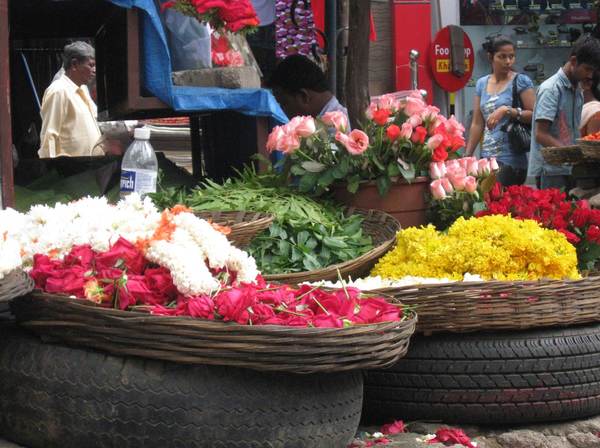
The flower vendors along the Gandhi Bazaar Main road
We started the walk at the Tagore circle at one end of the Gandhi Bazaar main road. It is a wonderful park. If you haven’t stepped in yet, you really must try to be there sometime. For one, it has a beautiful Peepul tree with a large stone platform around it (an ashwath katte). The paths in this neighbourhood park are beautifully shaded with bougainvillea and at one end there is a small open space where pigeons gather for food and water! There are several stone benches and there is much shade!
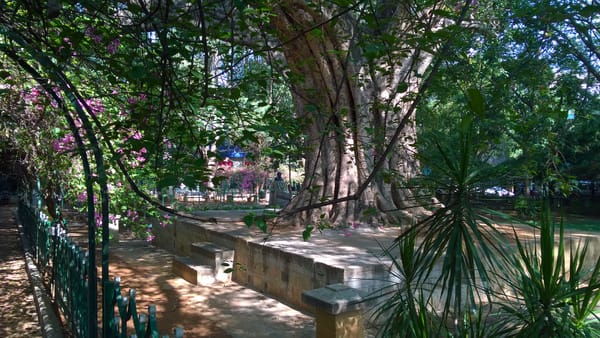
The ashwath katte (peepul tree platform) inside the park at Tagore circle.
As we stepped out of the park, we could see the Gandhi Bazaar in front of us with the large tree trunks of the rain trees on both sides of the road and the canopies that shaded also the entrance to our walk that day! Since most of the students are not Bangaloreans, actually none of them are, we had discussed the history of the neighbourhood a little – how the Basavanagudi grid layout had been planned soon after the Plague hit the city in 1898 and about the Krishna Rao Park that formed the centre of this layout. We also talked about the street bazaar in front of us and about how neighbourhoods were changing all over the city today. We had compared old maps and new maps while we had sat on the benches inside the Tagore circle park. Now, we looked for what was the “everyday” in this street and in this neighbourhood.
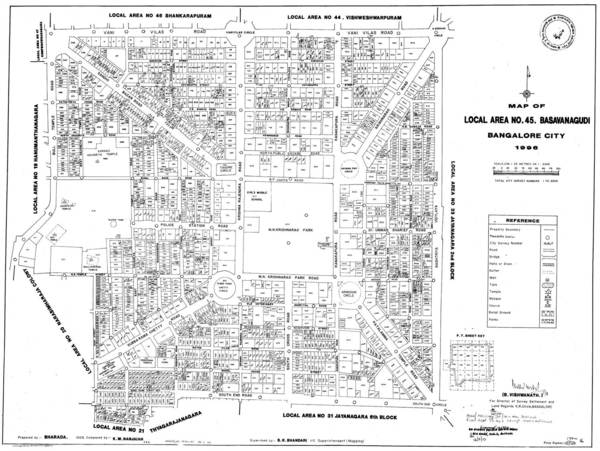
Basavanagudi Revenue Survey Map: 1996
Ever since I had done Bengaluru by foot’s Malgudi walk a year ago, I always remembered the M.N.Krishna Rao’s heritage house that Mansoor Ali had taken us to and perhaps how many such houses had stood here in Basavanagudi some years ago. There is still one such house facing the Tagore circle. However, the rest of the Gandhi bazaar main road has small and big buildings built in brick and concrete. There are no tiled roofed houses here anymore. Of course, our walk was about street space and it’s interface with everything else. So, while we talked about architectural hertiage a bit, we tried to observe people and how public space is used temporally – at different times of the day and the year.
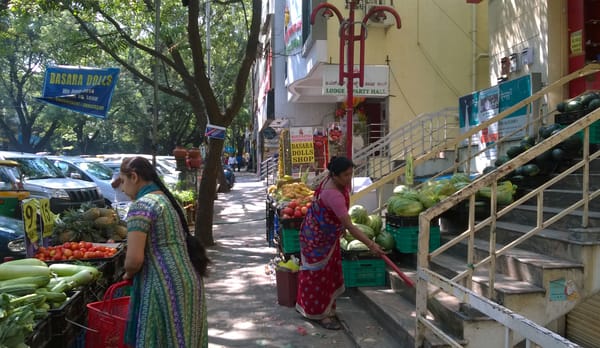
Foodworld puts out goods on display onto the footpath – the informality in the formal sector.
As we walked along one side of the road, we found ourselves walking through these boxes of fruits and vegetables that had price boards stuck into them. Suddenly realising this, we looked up to find that these were goods that had been put out for sale onto the footpath by Foodworld. We talked about this and one of the students pointed out that there could be two reasons for this: one, that this was a “street bazaar” and perhaps Foodworld was facing tough competition from the street vendors and, two, they were probably occupying the space just outside their shop just so that no street vendor could sell there. So, here were formal vendors being as informal as the “informal sector”.
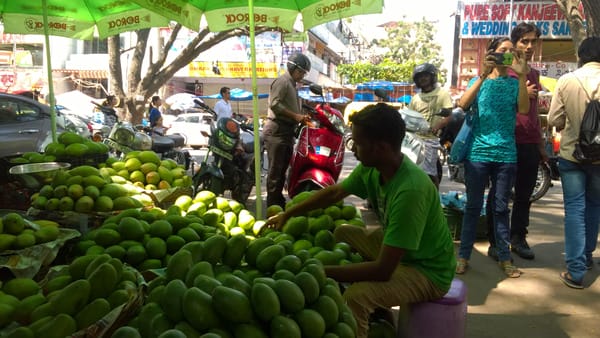
It’s summer time and there are vendors along the footpath selling raw mangoes.
We walked further onto the second half of the Gandhi Bazaar main road, after we had crossed Vidyarthi Bhavan and gone past the DVG road junction, noticing that on this stretch, the street vendors sold clothes and plastic items. No vegetable, fruits and flower vendors here. We reached the Ramkrishna Circle, turned the corner at MacDonald’s entering Bull temple road. While the first part of our walk was about Gandhi Bazaar, the second part of the walk was going to be about the Kadlekai Parishe or Groundnut fair. It was not that time of the year, but I had planned the walk that way. We were here to study everyday practices of people – which comprised of social, cultural, religious, economic and political practices. In the first stretch, we were discussing economic practices and in the second stretch, we were going to talk about social, cultural & religious practices during the Groundnut fair.
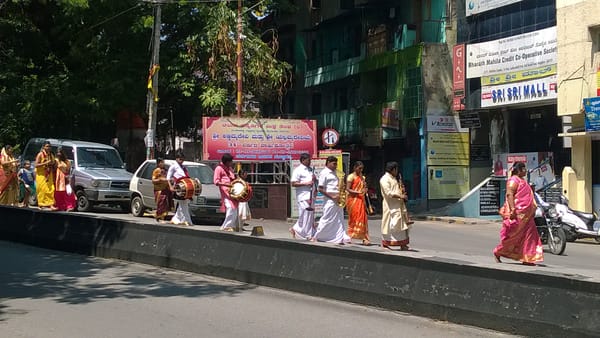
A marriage procession along the Bull temple road – another social & cultural practice that uses street space.
On the Bull temple road, there was the usual vehicular traffic, no groundnut vendors. There was a marriage procession along the street and flowers and music around the three kalyana mandapams that we passed by. We talked about the Kadlekai parishe story only after we got to the Bull temple and stood there in the shade! By then, we had experience a normal day along Bull temple road and we then compared it to a day during the Parishe, with the groundnut farmers and traders occupying the footpath sometimes a week before the festival. Earlier, I have researched on how the groundnut vendors mark and defend their territory during the Parishe. This has been published as a chapter titled ‘Territoriality in urban space: The case of a periodic marketplace in Bangalore’ in the book called ‘Informal Urban Street Markets’.
Our walk ended here. If you want to know the everyday spaces of the Basavanagudi neighbourhood, a 2-hour walk is just the beginning. You need to come here more than once, in the morning, in the evenings. You need to be here at different times of the year. You could do a Gandhi Bazaar tour that also includes the food places or you could come by on an afternoon in Festive Dussehra. There is much to see and much to know!